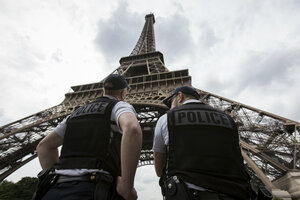Why is Paris putting glass walls around its Eiffel Tower?
The wall may reflect changes in the fabric of Parisian life following terrorist attacks, as officials beef up security and police powers.

French riot police officers patrol under the Eiffel Tower on June 10, 2016 before a Euro 2016 soccer match between France and Romania, in Paris. Paris authorities say Thursday, Feb. 9, 2017, they are proposing to replace the metal security fencing around the Eiffel Tower with a more aesthetically pleasing glass wall.
Kamil Zihnioglu/AP
Parisian authorities are planning to erect an 8-foot wall of reinforced glass around the Eiffel Tower, in a security measure designed to function as a more aesthetically pleasing replacement of a metal fence that went up last year for the Euro 2016 soccer championship.
Paris officials have also proposed a $318-million modernization of the 128-year-old monument that includes better elevators and lights, more security, and a renovated visitor entrance, according to CNN Money. Officials say that the new see-through panels will afford visitors a view of the monument from the popular Champ de Mars park and the Iena Bridge, unlike the metal fences.
"We will replace the metal grids to the north and south with glass panels which will allow Parisians and visitors a very pleasant view of the monument," the assistant mayor for tourism, Jean-Francois Martins, told the BBC.
The construction seems a symbol of how conspicuous security measures deployed by the French government in the wake of terrorist attacks have gradually become normalized, especially in tourist-heavy Paris.
"The terror threat remains high in Paris and the most vulnerable sites, led by the Eiffel Tower, must be the object of special security measures," Mr. Martins added.
The announcement one week after a machete attack on French troops stationed outside the Louvre Museum ended with the attacker, Egyptian citizen Abdullah Reda Al-Hamahmy, shot four times. He has told officials he wanted to damage paintings and “avenge the Syrian people,” according to Reuters. The museum was reopened last weekend after closing briefly, in what was perhaps a testament to much of the city's “business-as-usual” attitude toward the incident.
The November 2015 massacre in Paris, orchestrated by a man suspected by Belgian authorities of being an Islamic State fighter, was a turning point for security agencies in France and across Europe, with governments considering new means of intelligence-sharing and rethinking privacy safeguards, as The Christian Science Monitor’s Rachel Stern reported last February:
"Intelligence agencies are talking now, both because of the panic and, quite frankly, practically because lives are at stake," said Scott Stewart, vice president of tactical analysis at Stratfor, a global intelligence and advisory firm. "Politically we can’t be seen dropping that same ball again." Before the attacks, only half of the European Union's 28 countries participated in intelligence exchange through Europol, the EU's law enforcement agency, according to press spokesperson Jan Op Gen Oorth. Now all belong, and three are in the process of joining.
In France, the expansion of policing has been particularly aggressive, including the extension of emergency security measures originally put in place after the Paris attacks.
But as the Monitor’s Sara Miller Llana and Colette Davidson wrote in the days after those attacks, some French still worry about going too far toward a “whatever it takes” mentality.
“Not whatever it takes,” Paris resident Antoine Lippen told the Monitor at the time. “It would be too dangerous to block our own liberties when we know terrorist attacks are always cowardly attacks attacking at the place and time you least expect it, so there is always a breach in security, whatever is imposed.”
This report contains material from Reuters and the Associated Press.

